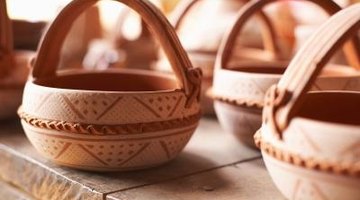Cooking With a Clay Pot on an Open Fire
Although some old technology isn't practical for modern usage, some methods -- especially cooking methods -- may come in handy during camping trips, bonfires or during an emergency situation. Before gas and electric stoves, people cooked over fires, usually in earthenware clay pots. While time-consuming, cooking in clay isn't complicated as long as you stick to a few key rules.

-
Pour about 2 inches of cool water into the bottom of your clay pot.
-
Place the clay pot next to your fire on the hearth or on a flat rock. Turn the pot every 10 minutes or so until the pot feels evenly warm to the touch. If you try to heat or cool a clay pot too quickly, it will shatter.
-
Pour off the water and coat the bottom of your clay pot with cooking oil. Add onions and slow-cooking vegetables (celery and root veggies) to the pot first. Place the pot back on the rock, turning it every 10 minutes, as before.
-
Check the root vegetables every 20 minutes; when they break apart easily but aren't yet mushy, add your meat. Smaller pieces of meat seal and cook more evenly than large steaks and chicken breasts.
-
Stir your meal gently each time you turn the pot to keep the pieces from burning. Every other time you turn the pot, check your pieces for dryness. If your food appears to be drying out rather than cooking and softening, drizzle it with oil or a little water. About a spoonful should do; too much moisture will turn your meal to mush.
-
Add fast-cooking veggies (peas, tomatoes) when your meat is seared on all sides and appears to be turning brown. Check these veggies each time you turn your pot; when they're fork-soft, you're ready to eat.
References
Tips
- Cooking pots must be glazed, at least on the inside, to prevent moisture absorption and mold.
Photo Credits
- Jupiterimages/Photos.com/Getty Images
More Articles



